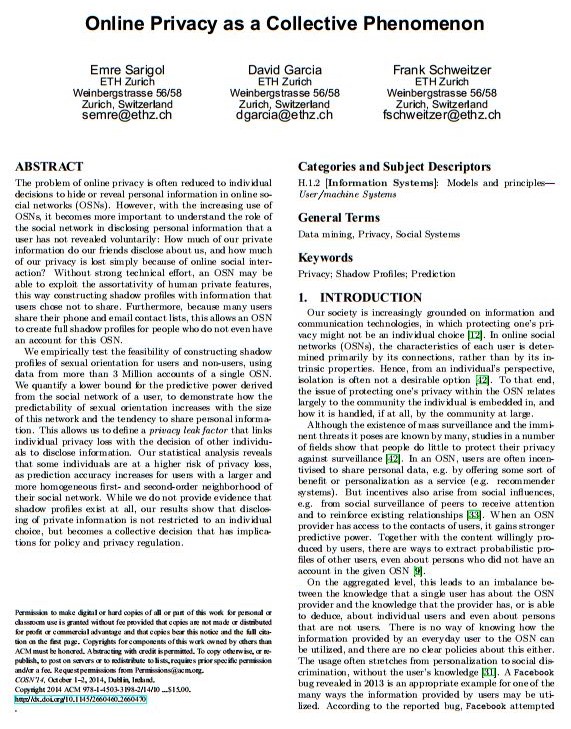不玩社交网络,隐私还是个事儿!
作者 AbelJiang | 2014-10-06 09:21 | 类型 机器学习 | Comments Off
|
节选自:http://www.wired.com 感兴趣可以看原文,较长,节选部分翻译 拜重度收集癖患者Google和Facebook所赐,只要你使用社交网络,就可以和隐私说拜拜了。但是最新的一项研究显示,即使你不用社交网络,这些公司还是可以挖掘出你的信息。确实有点吓人。 研究者无法从Facebook或是LinkedIn拿到数据,于是选择了对外公开存档数据的,相对较老的社交网络Friendster进行研究。研究者发现,如果Friendster使用某些先进预测算法,可以估测出一些非Friendster用户的敏感信息,比如一些非注册用户的性取向。 这项研究的作者之一,来自ETH Zurich university的David Garcia称,对于小众类别,比如同性恋,他的分析技术精度可以达到60%,而普通的分类算法精度不到5%。这篇论文仅分析了性取向,但是Garcia认为,这种分析方法同样适用于年龄,情感状况,职业,甚至政治立场。 值得一提的是在Facebook做得越来越大,越来越强调广告盈利,越来越多的涉足用户隐私问题的同时,一个刚诞生两个多月的Facebook替代品Ello,正以每小时50000名新注册用户的势头迅速崛起。Ello没有广告,并且允许用户使用非真实姓名,这也受到了不愿透露真实姓名边缘群体同性恋,双性人,变性人的欢迎。 | |
NSA的私有云揭密
作者 陈怀临 | 2014-10-06 09:20 | 类型 行业动感 | Comments Off
|
The National Security Agency (NSA) had a problem familiar to any enterprise IT manager executive: it was running out of space for hundreds of disparate relational databases that contain everything from back-office information to intelligence on foreign interests. And it needed to consolidate those databases to make it easier for NSA analysts to do their job. The NSA’s initial approach was to scale up capacity. But halfway through the process, the staff realized that simply increasing the scope of the network was not going to work. So, CIO Lonny Anderson convinced General Keith Alexander, who was then Director of the NSA and Commander of U.S. Cyber Command, to approve a move to the cloud. Today, as the private cloud project continues to be rolled out, the agency is seeing the benefits. Tasks that took analysts days now take as little as minutes, costs have been reduced, and the management and protection of information has taken a huge step forward. To learn about this effort, which dates back to 2009, Network World was invited to interview Anderson at NSA headquarters in Fort Meade, Md. He explained that the goal was to create an environment sufficiently large to handle the data repositories and to ensure that analysts would have the user-facing experience of one-stop-shopping that the cloud can provide. He also pointed out that the NSA effort is part of a larger migration of U.S. intelligence agencies to the cloud. In 2011, sequestration forced the Department of Defense to absorb “huge budget cuts,’’ says Anderson. The agencies “decided to economize by sharing IT services and thereby avoid a drastic slash,” says Anderson. The NSA, CIA, National Geospatial Intelligence Agency (NGA), National Reconnaissance Office (NRO), and Defense Intelligence Agency (DIA) divvied up the responsibilities, with NSA and CIA handling the cloud infrastructure; NGA and DIA taking on the desktop; and NRO focusing on network requirements and engineering services. In addition to saving on cost, putting all intelligence community data in the same bucket is enhancing the speed, depth and efficacy of their work. Inside the cloudAnderson describes the private cloud as “an integrated set of open source and government developed services on commercial hardware that meets the specific operational and security needs of NSA and Intelligence Community (IC) m IC[DS1] mission partners. NSA is part of an Office of the Director of National Intelligence (ODNI) effort to migrate to a community cloud that brings together NSA’s cloud services with commercial cloud services at the classified level.” While more details could not be obtained due to security restrictions, we learned that it is based on the same commodity hardware used by public cloud providers. It also uses open source products such as Apache Hadoop, Apache Accumulo, OpenStack, and “a variety of other tools, packages, and virtualization layers.” It would not be a surprise to learn that the NSA’s private cloud resides within secure government facilities. Anderson says, “It saves space by combining and consolidating multiple independent services and systems. In addition, we take advantage of the economies of scale from commodity hardware and the continuous improvements by commercial markets to save space, power, and cooling; the same efficiencies used by the commercial public cloud services.” | |








